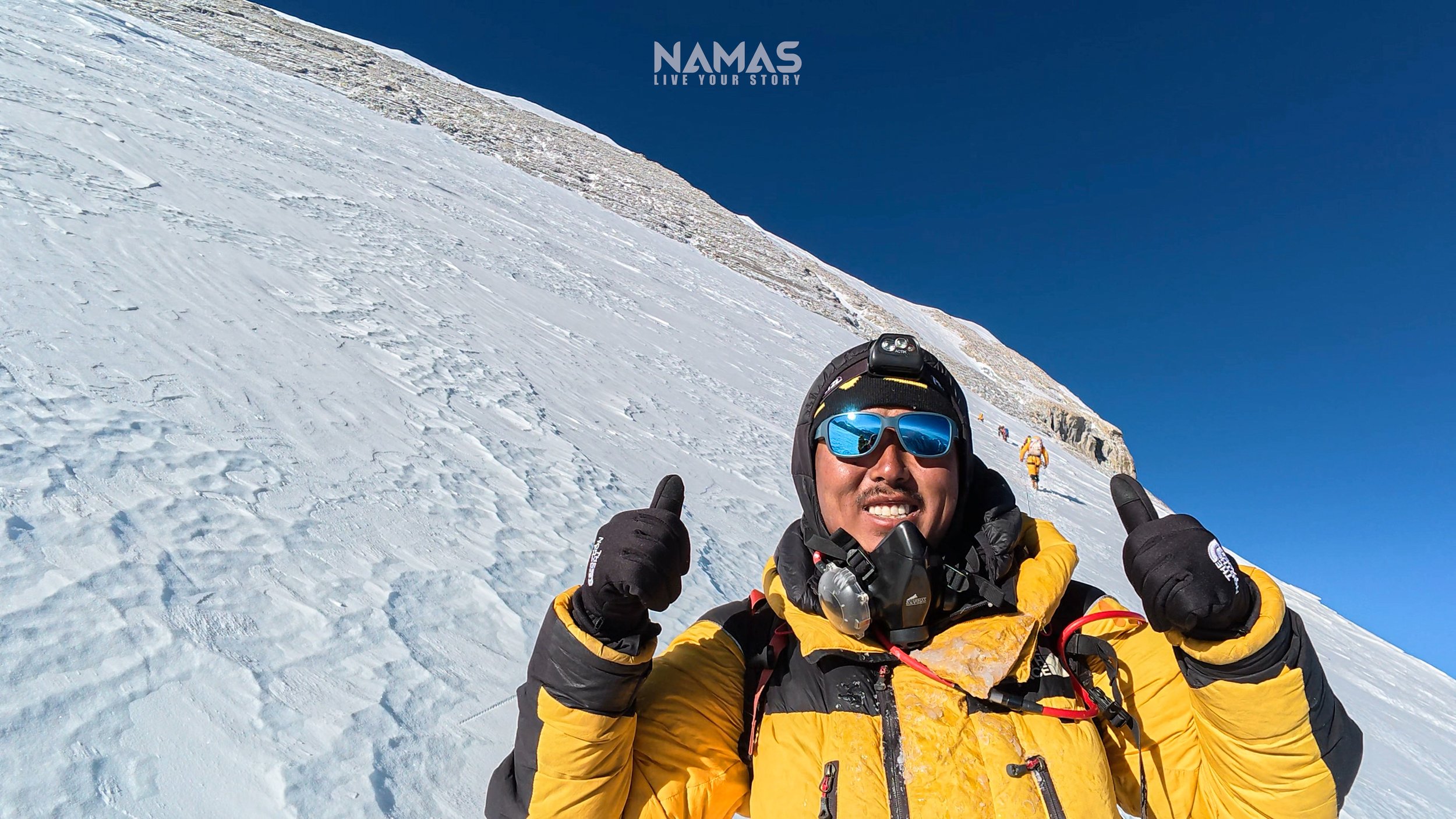2025 Annapurna 1 climb, as it happened - Report Namas Adventure
Hey everyone, this is Bisesh (Chief Adventurer) from Team NAMAS.
It’s been a month (7th April) since our attempt on Annapurna I—one of the world’s most dangerous mountains. We reached just 50 meters shy of the summit before making the hardest decision of my climbing career. But before I share that story, I want to honor two brave souls who never made it home.
In Memory of Ngima Tashi Sherpa and Rima Rinje Sherpa
On April 7, 2025, an avalanche between Camp 2 and Camp 3 claimed the lives of two Sherpa brothers: Ngima Tashi Sherpa and Rima Rinje Sherpa (On guiding assignment with - Seven Summit treks). They were ferrying oxygen cylinders in preparation for summit pushes when the avalanche struck. Ngima was from Thame, the same village as many of our guides, and I had the pleasure of sharing tea and hearing his Everest rescue stories with him during our 2024 Everest expedition. Rima, only 27, leaves behind a wife and two young children. Their loss is a stark reminder of the perils faced by those who make these expeditions possible.
The Climb Begins
Our expedition commenced on March 17 with an acclimatization trek to Mardi Himal, where we spent a night at 4,100 meters. We then flew directly to Annapurna I North Base Camp, arriving well-acclimatized on March 25. Reports indicated that the route to Camp 3 had been fixed by March 19, and Imagine Nepal's team was aiming for a summit by the end of March.
We began our rotation on March 27, coinciding with the descent of the Imagine Nepal team. To our surprise, they hadn't summited due to a shortage of ropes—500 meters short of the summit. This unexpected development left us and other teams pondering the next steps.
During rotation, resting between camp 1 and 2. Appreciating the chaos and beauty of nature.
After completing our rotation and returning to Base Camp on March 29, discussions ensued among the teams. It was decided that Imagine Nepal would attempt to fix the remaining ropes by April 3, with summit bids planned for April 4 or 5. However, forecasts predicted heavy snowfall from April 8 onward, increasing avalanche risks. Even with minimal snow, avalanches were frequent—5 to 6 daily—making this one of the most avalanche-prone areas I've experienced in my decade of climbing.
The Summit Push
With a favorable weather window, we rested at Base Camp for four days. However, on April 3, we learned that Imagine Nepal couldn't fix the remaining ropes. In a last-minute collaboration, all major teams agreed to share the workload of fixing the final 500-600 meters near the summit.
Our summit bid began:
April 3: Ascended to Camp 1
April 4: Moved to Camp 2
April 5: Reached Camp 3
Exhausted, we decided to rest on April 5 and commenced our summit push at 10 PM on April 6. We allocated 15 hours for the ascent and 5-6 hours for the descent. Before departure, we were informed that approximately 600 meters will be fixed on the same morning by collective of Sherpa guides from all the teams that were preset during the summit push on 7th April morning.
The Final 50 Meters: A Decision on the Edge
We started our summit push from Camp 3 at 10 PM on April 6. Conditions were excellent—clear skies, low winds, and I felt physically strong. The climb progressed smoothly, and moved well through the night.
At around 7,800 meters, we noticed the ropes had ended. By 8,000 meters, we saw a guide dragging a rope upward, which confirmed our concern: the new ropes weren’t fully fixed. Near the final couloir—just 50 vertical meters from the summit—we paused.
Ahead of us, 20+ climbers were already clipped to old ropes from previous years. Anchors were visibly worn, and the rope swayed under the weight of multiple climbers. We estimated a 30–45 minute or even more delay for the new fixing effort to reach us, if at all.
This was it: summit within sight. I checked the time and it was 13 hours into our climb. I had two full oxygen bottles left. I was on time, had energy, and the weather was perfect.
But what I saw made me stop and really think through my decision to proceed further. This was a 3,000–4,000 meter vertical drop below us. If that old rope gave way, it would be catastrophic—not just for the climbers ahead but for everyone clipped in, including us. And I had no idea where the fixing team was or if backup fixing team would ever come. At that moment, my gut spoke louder than ambition. Everything in me said: Turn around.
The Descent
the most notorious and deadliest section in the entire climb.
I called it. My team—though hesitant—understood. We carefully made our way back to Camp 3, just 50 meters below the summit, with heavy hearts but sound judgment.
Two hours into our descent, I was clipped into a rope, slowly abseiling down the steep face. As I paused to shift my weight, my guide—positioned just above—shouted and pointed into the distance. I turned around. A massive white cloud was surging down the slopes beneath us—an avalanche, roaring like thunder through the valley.
For a moment, everything stood still. I was gripped by the chilling realization: had we summited and descended just a day earlier, we could’ve been right in its path near Camp 3. We exchanged quiet glances—half in relief, half in disbelief.
About thirty minutes later, crackling through the static of our radio came the news: two climbers had been caught in that avalanche. Their names were still unknown. We continued down in silence, a heavy weight growing with each step.
The next day, just before reaching Base Camp, we learned the names. It was Nima and Rinji. Our hearts sank. Paljor, our guide, froze in disbelief. He had gone to school with Nima. None of us could speak. The mountain had taken two more—just like that. The silence that followed said everything words couldn’t.
Despite being physically exhausted and emotionally drained, Paljor didn’t hesitate. The moment he heard the news, he made his way straight to the Seven Summit base camp, where Nima’s brother had just arrived, shattered by the loss.
That night, Paljor stayed by his side—offering quiet comfort, holding space for his grief, and doing whatever he could to ease an unimaginable pain. Even in his own sorrow, he put others first. It was a quiet act of brotherhood in the face of tragedy.
Reflections
It wasn’t an easy decision. After years of training, weeks of effort, and being so close—you question everything. Would I have made it safely? Probably. Others summited that day, using the old ropes. But what if I had added one more person’s weight? What if the rope failed?
In the mountains, you must always respect your intuition. We were there to challenge ourselves, yes—but not at the cost of our lives. I often think about those last 50 meters, but I never regret the decision. I came back safe, with my team, and I know we’ll return stronger.
For me, Annapurna I is the raw, unfiltered story of true high-altitude mountaineering—steeped in danger, doubt, and determination. Every step is a dance with risk, every corner a whisper of warning. The climb is brutal, the terrain unforgiving, and the mountain constantly reminds you: it sets the rules, not you.
Climbing Annapurna doesn’t feel like a triumph—it feels like survival. You don’t conquer this peak; you get through it, if it allows you.
Respect isn’t optional here—it’s essential. Everything has to align: timing, weather, judgment, and a fair share of luck. That climb to Camp 1 alone is a harsh lesson in fragility and fate. Annapurna doesn’t just test your strength—it humbles your soul.
Thank you, Annapurna for showing us a safer path this time, perhaps the summit story is for another day. For now I leave with content heart and humbled soul. Namaste 🙏🏼
Namas Adventure
Live Your Story
TEAM NAMAS. 2025 ANNAPURNA 1, 8091M. From left - Sherap Sherpa, Paljor Sherpa, Me - Bisesh Gurung, Client Ian and Dawa Sherpa.






